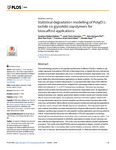Mostrar o rexistro simple do ítem
Statistical degradation modelling of Poly(D,L-lactide-co-glycolide) copolymers for bioscaffold applications
| dc.contributor.author | Robles-Bykbaev, Yaroslava | |
| dc.contributor.author | Tarrío-Saavedra, Javier | |
| dc.contributor.author | Quintana-Pita, Sara | |
| dc.contributor.author | Díaz-Prado, Silvia | |
| dc.contributor.author | García Sabán, Francisco Javier | |
| dc.contributor.author | Naya, Salvador | |
| dc.date.accessioned | 2018-10-11T10:22:51Z | |
| dc.date.available | 2018-10-11T10:22:51Z | |
| dc.date.issued | 2018-10-01 | |
| dc.identifier.citation | Robles-Bykbaev Y, Tarrío-Saavedra J, Quintana-Pita S, Díaz-Prado S, García Sabán FJ, Naya S. Statistical degradation modelling of Poly(D,L-lactide-co-glycolide) copolymers for bioscaffold applications. PLOS One. 2018;13(10):e0204004 | es_ES |
| dc.identifier.issn | 1932-6203 | |
| dc.identifier.uri | http://hdl.handle.net/2183/21147 | |
| dc.description.abstract | [Abstract] This methodology permits to simulate the performance of different Poly(D,L-lactide-co-glycolide) copolymer formulations (PDLGA) in the human body, to identify the more influencing variables on hydrolytic degradation and, thus, to estimate biopolymer degradation level. The PDLGA characteristic degradation trends, caused by hydrolysis processes, have been studied to define their future biomedical applications as dental scaffolds. For this purpose, the mass loss, pH, glass transition temperature (Tg) and absorbed water mass of the different biopolymers have been obtained from samples into a phosphate-buffered saline solution (PBS) with initial pH of 7.4, at 37°C (human body conditions). The mass loss has been defined as the variable that characterize the biopolymer degradation level. Its dependence relationship with respect to time, pH and biopolymer formulation has been modelled using statistical learning tools. Namely, generalized additive models (GAM) and nonlinear mixed-effects regression with logistic and asymptotic functions have been applied. GAM model provides information about the relevant variables and the parametric functions that relate mass loss, pH and time. Mixed effects are introduced to model and estimate the degradation properties, and to compare the PDLGA biopolymer populations. The degradation path for each polymer formulation has been estimated and compared with respect to the others for helping to use the proper polymer for each specific medical application, performing selection criteria. It was found that the mass loss differences in PDLGA copolymers are strongly related with the way the pH decay versus time, due to carboxylic acid groups formation. This may occur in those environments in which the degradation products remain relatively confined with the non degraded mass. This is the case emulated with the present experimental procedure. The results show that PDLGA polymers degradation degree, in terms of half life and degradation rate, is increasing when acid termination is included, when DL-lactide molar ratio is reduced, decreasing the midpoint viscosity, or when glycolide is not included. | es_ES |
| dc.description.sponsorship | The research of Salvador Naya and Javier Tarrío‐ Saavedra has been partially supported by the Xunta de Galicia (Centro Singular de Investigación de Galicia accreditation [ED431G/01 2016‐2019] and Grupos de Referencia Competitiva [ED431C2016‐015]) and by the MINECO [Grant MTM2014‐52876‐R]. These grants are cofunded by the European Union (European Regional Development Fund ‐ ERDF). The research of Yaroslava Robles has been supported by the Ecuador’s Secretaría Nacional de Educación Superior, Ciencia, Tecnología e Innovación (SENESCYT) and Inditex‐UDC International Doctoral School Grant for pre‐doctoral students. Francisco Javier García Sabán and Sara Quintana‐Pita are employed by DevelopBiosystem SL. DevelopBiosystem SL provided support in the form of salaries for J.G.S and S.Q.P. authors, but did not have any additional role in the study design, data collection and analysis, decision to publish, or preparation of the manuscript. The specific roles of these authors are articulated in the author contributions section. | |
| dc.description.sponsorship | Xunta de Galicia; ED431G/01 2016‐2019 | |
| dc.description.sponsorship | Xunta de Galicia; ED431C2016‐015 | |
| dc.description.sponsorship | info:eu-repo/grantAgreement/MINECO/Programa Estatal de I+D+I Orientada a los Retos de la Sociedad/MTM2014-52876-R/ES/INFERENCIA ESTADISTICA COMPLEJA Y DE ALTA DIMENSION: EN GENOMICA, NEUROCIENCIA, ONCOLOGIA, MATERIALES COMPLEJOS, MALHERBOLOGIA, MEDIO AMBIENTE, ENERGIA Y APLICACIONES INDUSTRIALES | |
| dc.language.iso | eng | es_ES |
| dc.publisher | PLOS | es_ES |
| dc.relation.uri | https://doi.org/10.1371/journal.pone.0204004 | es_ES |
| dc.rights | Creative Commons Attribution 4.0 International Licence (CC-BY 4.0) | es_ES |
| dc.rights.uri | http://creativecommons.org/licenses/by/4.0/ | * |
| dc.title | Statistical degradation modelling of Poly(D,L-lactide-co-glycolide) copolymers for bioscaffold applications | es_ES |
| dc.type | info:eu-repo/semantics/article | es_ES |
| dc.rights.access | info:eu-repo/semantics/openAccess | es_ES |
| UDC.journalTitle | PLOS one | es_ES |
| UDC.volume | 13 | es_ES |
| UDC.issue | 10 | es_ES |
| UDC.startPage | e0204004 | es_ES |
Ficheiros no ítem
Este ítem aparece na(s) seguinte(s) colección(s)
-
INIBIC-TCMR - Artigos [102]






